
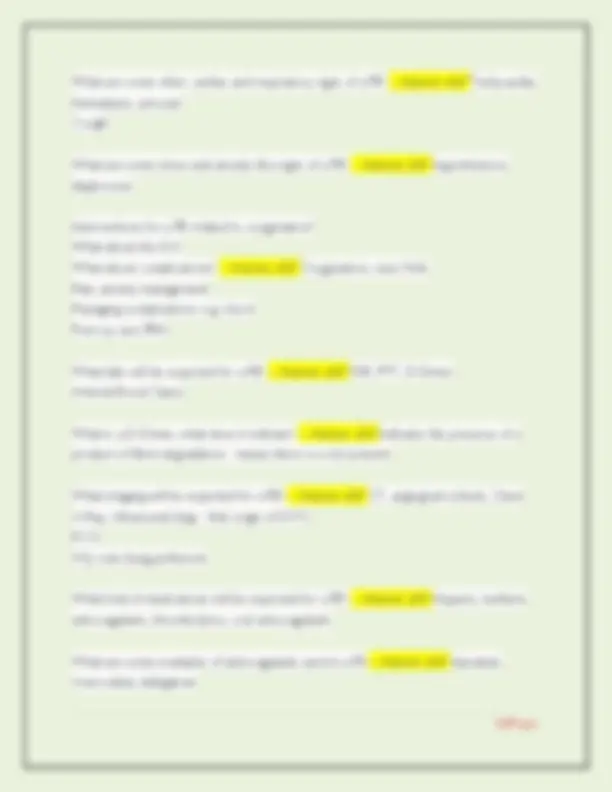
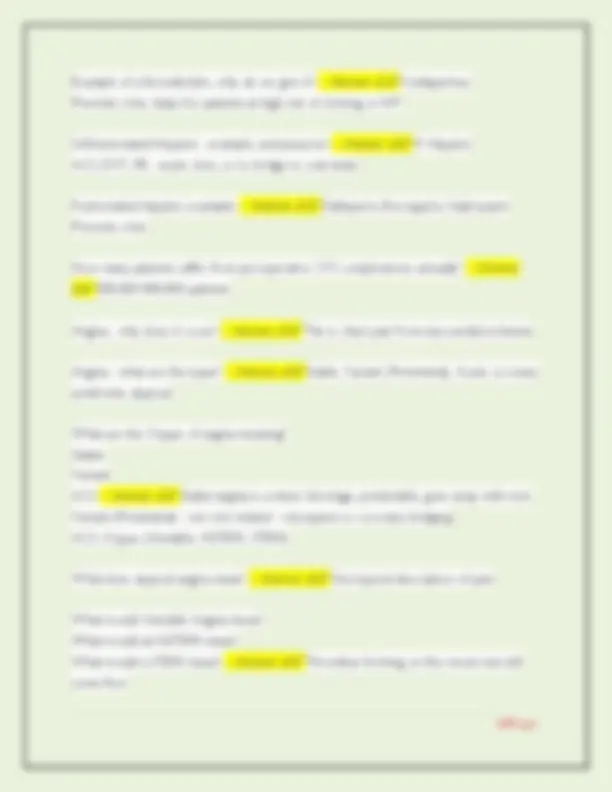
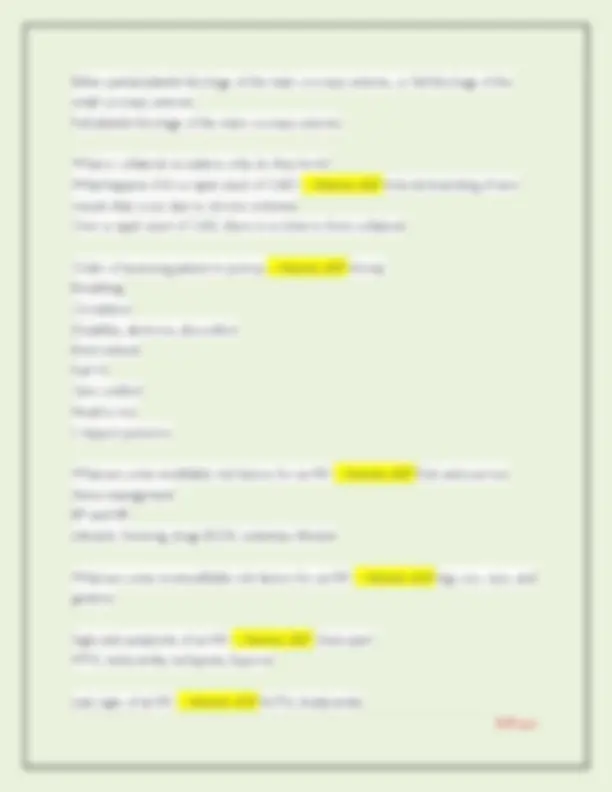
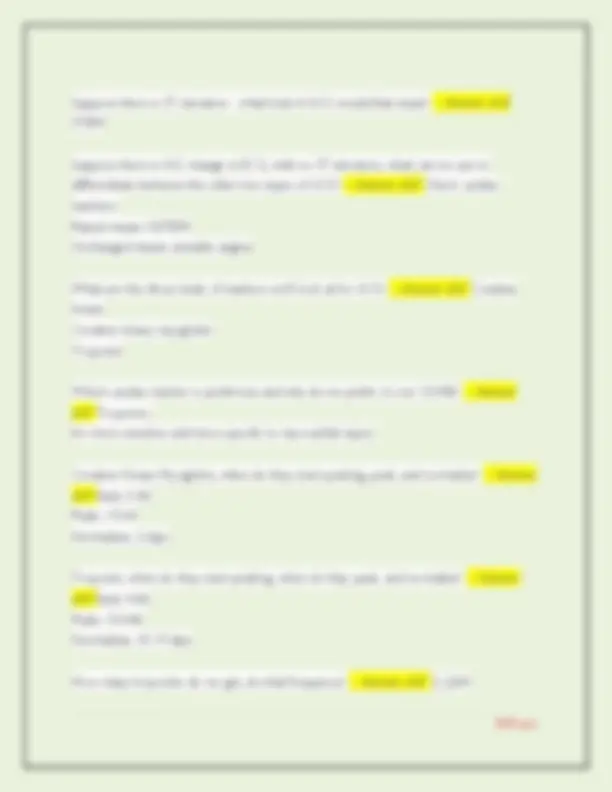
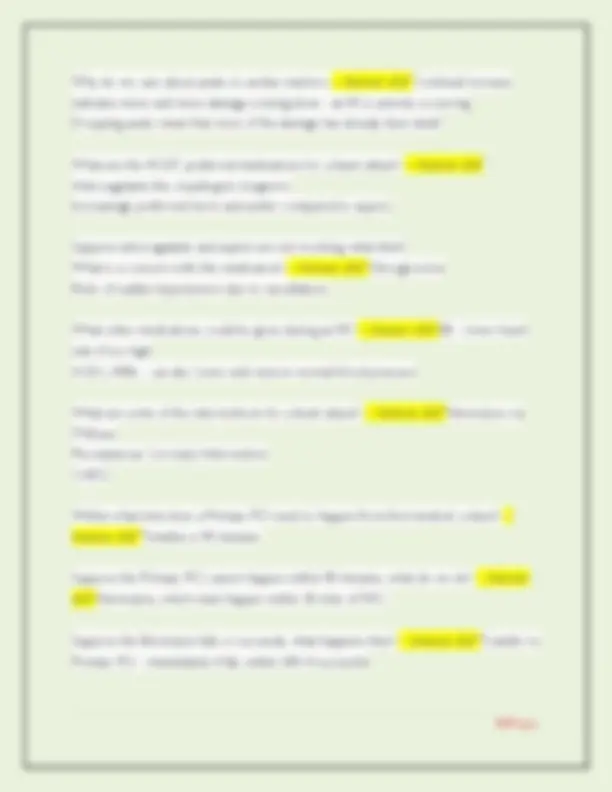
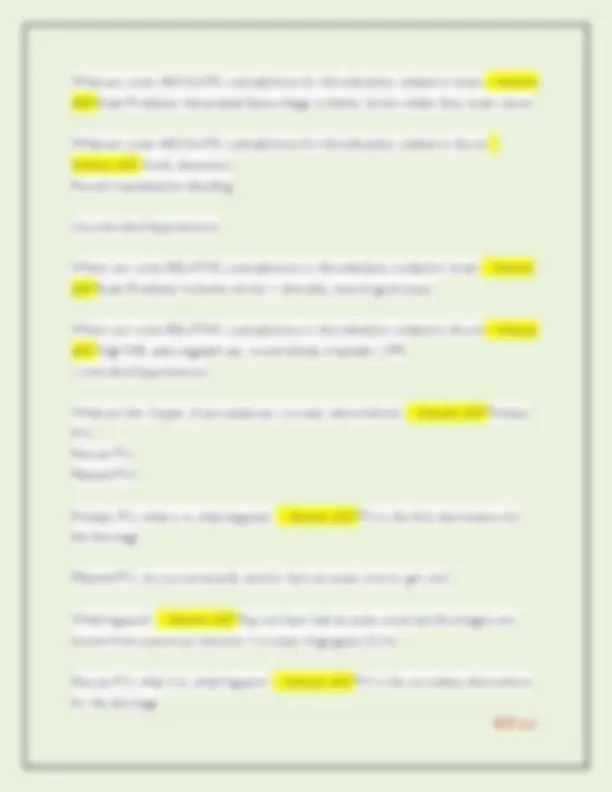


Study with the several resources on Docsity

Earn points by helping other students or get them with a premium plan


Prepare for your exams
Study with the several resources on Docsity

Earn points to download
Earn points by helping other students or get them with a premium plan
Community
Ask the community for help and clear up your study doubts
Discover the best universities in your country according to Docsity users
Free resources
Download our free guides on studying techniques, anxiety management strategies, and thesis advice from Docsity tutors
A comprehensive overview of chest pain causes, including cardiovascular, respiratory, gastrointestinal, and psychological factors. It delves into the pathophysiology of atherosclerosis and pulmonary embolism, outlining risk factors, signs, symptoms, and interventions. The document also explores the different types of angina, their characteristics, and the importance of cardiac markers in diagnosis. It concludes with a discussion of interventions for heart attacks, including fibrinolysis and percutaneous coronary intervention.
Typology: Exams
1 / 11

This page cannot be seen from the preview
Don't miss anything!







What kind of categories of problems can cause chest pain? -- Answer ✔✔ GI, Respiratory CVS Hyperadrenergic states Chest wall Psychological What kind of GI conditions can cause chest pain? What does it feel like? -- Answer ✔✔ GERD, esophageal pain, abnormal motility, gas Feels like heartburn What kind of respiratory conditions can cause chest pain? What does it feel like? -- Answer ✔✔ Pulmonary embolism, hypertension Cor Pulmonale [RSHF], Damage to lung parenchyma, Asthma/COPD Pneumothorax Feels sharp What kind of chest wall, and psychological conditions can cause chest pain? -- Answer ✔✔ MSKL, nerve pain Panic, depression What kind of hyperadrenergic states can cause chest pain? -- Answer ✔✔ Stress induced cardiomyopathy
Drug use Pheochromocytoma - cancer What kind of categories of CVS problems can cause chest pain What does it feel like -- Answer ✔✔ Ischemic, nonischemic problems, valvular problems Feels like a tightening/pressure What are some ischemic cardiac conditions -- Answer ✔✔ CAD Vasospasm Angina What are some nonischemic cardiac conditions -- Answer ✔✔ Inflammation - pericarditis, myocarditis Acute aortic syndromes A.fib How does atherosclerosis develop? -- Answer ✔✔ Chronic endothelial injury - > Lipids accumulate, migrate into smooth muscle cells-> Collagen covers the fatty streak, lumen gets smaller, flow is reduced-> Further damage reduces it more What is Virchow's Triad and its components? -- Answer ✔✔ DVT risk factors Venous stasis, hypercoagulability, vessel damage What are PE risk factors? -- Answer ✔✔ •Associated with trauma, sx pregnancy, HF, age > What are the main signs of a PE? -- Answer ✔✔ •Dyspnea •Tachypnea •CP sudden onset - pleuritic
Example of a thrombolytic, why do we give it? -- Answer ✔✔ Fondaparinux Prevents clots, helps for patients at high risk of clotting or HIT Unfractionated Heparin - example, and purpose? -- Answer ✔✔ IV Heparin ACS, DVT, PE - acute clots, or to bridge to oral meds Fractionated heparin, examples -- Answer ✔✔ Dalteparin, Enoxaparin, Nadroparin Prevents clots How many patients suffer from perioperative CVS complications annually? -- Answer ✔✔ 500,000-900,000 patients Angina - why does it occur? -- Answer ✔✔ This is chest pain from myocardial ischemia Angina - what are the types? -- Answer ✔✔ Stable, Variant (Prinzmetal), Acute coronary syndrome, atypical What are the 3 types of angina meaning? Stable Variant ACS -- Answer ✔✔ Stable angina is a minor blockage, predictable, goes away with rest. Variant (Prinzmetal) - not clot related - vasospasm or coronary bridging ACS: 3 types (Unstable, NSTEMI, STEMI) What does atypical angina mean? -- Answer ✔✔ Non-typical description of pain What would Unstable Angina mean? What would an NSTEMI mean? What would a STEMI mean? -- Answer ✔✔ Thrombus forming on the vessel, but still some flow
Either partial platelet blockage of the main coronary arteries, or full blockage of the small coronary arteries Full platelet blockage of the main coronary arteries What is collateral circulation, why do they form? What happens if it’s a rapid onset of CAD? -- Answer ✔✔ Arterial branching of new vessels that occur due to chronic ischemia Over a rapid onset of CAD, there is no time to form collateral Order of assessing patient in postop -- Answer ✔✔ Airway Breathing Circulation Disability, dextrose, discomfort Environment Full VS Give comfort Head to toe I: Inspect posterior What are some modifiable risk factors for an MI? -- Answer ✔✔ Diet and exercise Stress management BP and HR Lifestyle: Smoking, drugs EtOH, sedentary lifestyle What are some nonmodifiable risk factors for an MI? -- Answer ✔✔ Age, sex, race, and genetics Signs and symptoms of an MI? -- Answer ✔✔ Chest pain! HTN, tachycardia, tachypnea, hypoxia Late signs of an MI? -- Answer ✔✔ HoTN, bradycardia
When monitor is examined can correlate events to monitor activity What is the P wave, what does it refer to, and what is the heart doing? -- Answer ✔✔ P wave: refers to depolarization - contraction of atria What is the QRS wave, what does it refer to, and what is the heart doing? -- Answer ✔✔ QRS: depolarization of ventricles, contraction of the ventricles What us the T wave, and ST wave -- Answer ✔✔ T wave is the repolarization of the ventricles ST segment is the relaxation of the heart muscles Why do we not see any reading for the atria repolarizing? -- Answer ✔✔ The QRS wave covers it up What are the 4 criteria to confirm something is a sinus rhythm? -- Answer ✔✔ Is there a P wave that is upright and rounded? After the P wave, is there a QRS that is upright? Is it regular? Is there a T wave that is upright? What kind of myocardial infarction shows with a depressed ST wave? Is it the more severe or less severe kind of MI? -- Answer ✔✔ NSTEMI less What does ST elevation in the anterior/septal region look like? Do we like this? -- Answer ✔✔ ST elevation in the anterior/septal region looks like a 'gun', a gun and you're done - we don't like it. How are leads placed? -- Answer ✔✔ Each has a specific location referring to a specific area of the heart - not placed haphazardly
Suppose there is ST elevation - what kind of ACS would that mean? -- Answer ✔✔ STEMI Suppose there is NO change in ECG, with no ST elevation, what can we use to differentiate between the other two types of ACS? -- Answer ✔✔ Check cardiac markers: Raised means NSTEMI Unchanged means unstable angina What are the three kinds of markers we'll look at for ACS? -- Answer ✔✔ Creatine kinase Creatine kinase myoglobin Troponin Which cardiac marker is preferred, and why do we prefer it over CKMB? -- Answer ✔✔ Troponin, It's more sensitive and more specific to myocardial injury Creatine Kinase Myoglobin, when do they start peaking, peak, and normalize? -- Answer ✔✔ Early 2-3h Peaks 15- 24 Normalizes 3 days Troponin, when do they start peaking, when do they peak, and normalize? -- Answer ✔✔ Early 4-6h Peaks 10-24h Normalizes 10-15 days How many troponins do we get, at what frequency? -- Answer ✔✔ 3, Q6H
What are some ABSOLUTE contradictions for thrombolytics related to brain -- Answer ✔✔ Brain Problems: Intracranial hemorrhage, ischemic stroke within 3mo, brain cancer What are some ABSOLUTE contradictions for thrombolytics related to blood -- Answer ✔✔ Aortic dissection Recent trauma/active bleeding Uncontrolled Hypertension Where are some RELATIVE contradictions to thrombolytics related to brain -- Answer ✔✔ Brain Problems: Ischemic stroke > 3months, neurological issues Where are some RELATIVE contradictions to thrombolytics related to blood -- Answer ✔✔ High INR, anticoagulant use, recent bleeds, traumatic CPR Controlled Hypertension What are the 3 types of percutaneous coronary interventions? -- Answer ✔✔ Primary PCI Rescue PCI Planned PCI Primary PCI, what is it, what happens? -- Answer ✔✔ PCI is the first intervention for the blockage Planned PCI, do you necessarily need to have an acute even to get one? What happens? -- Answer ✔✔ May not have had an acute event but block(ages) are known from a previous Selective Coronary Angiogram (SCA) Rescue PCI, what is it, what happens? -- Answer ✔✔ PCI is the secondary intervention for the blockage
Why would we use a CABG? -- Answer ✔✔ Coronary artery bypass graft Totally bypass multiple blockages What are they key aspects of assessing for cardiac problems? What tools to help assessments? What initial medications? What interventions? -- Answer ✔✔ Really good assessment including thorough PAIN ASSESSMENT 12 lead ECG Cardiac enzymes - mainly troponin P2Y12 & ASA are key!!! Get intervention: TNKase, PCI, and/or CABG